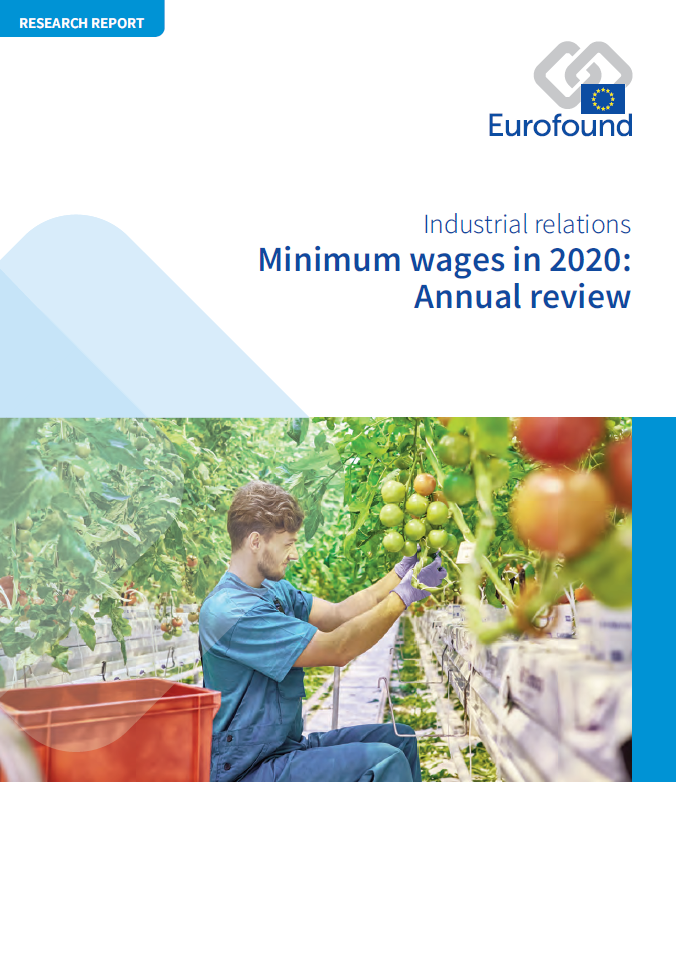
В настоящия доклад, като част от ежегодна поредица относно минималните работни заплати, са обобщени основните развития за 2019 г. и началото на 2020 г., свързани с инициативата на ЕС за справедливи възнаграждения, и се поставят в този контекст националните обсъждания относно определянето на ставките за 2020 г. и след това. В доклада е включен начинът на определяне на минималните работни заплати и ролята на социалните партньори. Обсъдени са развитията в областта на законоустановените минимални заплати и са представени данни относно минималните ставки на заплащане в колективни трудови договори, свързани с 10 ниско платени професии за държави, в които няма законоустановени минимални заплати. В доклада е включен и раздел относно регионалното измерение на минималните работни заплати и е представено последното проучване относно последиците от промените на минималните работни заплати за работните заплати, заетостта, бедността сред работещите, цените и доходите.
Key findings
През 2019 г. в много държави се проведе обсъждане относно допълнително значително увеличение на минималните работни заплати след 2020 г., отчасти във връзка с относителна цел и отчасти в абсолютни стойности.
Законоустановените минимални заплати са станали по-справедливи в сравнение с други работни заплати от началото на хилядолетието (при сравнение на законоустановените минимални заплати със средните работни заплати на всички работещи).
Въпреки тази възходяща тенденция, минималните работни заплати в повечето държави остават под 60 % или дори под 50 % от средните работни заплати. Това важи особено за централните и източните държави членки, които започнаха от много ниски относителни равнища в началото на хилядолетието и продължават да поддържат целеви равнища от около или под 50 % в своите разпоредби относно минималните работни заплати.
Като цяло 7 на всеки 10 работещи с минимална работна заплата съобщават за някакви финансови затруднения в сравнение с по-малко от 5 на всеки 10 от останалите работещи; тези стойности обаче се различават значително в отделните държави. Например, в Дания, Финландия, Германия и Швеция по-малко от 10 % от работещите с минимална работна заплата имат големи до много големи финансови затруднения; за сравнение, тази стойност в България, Хърватия и Кипър достига 50 % до 60 %, а в Гърция — 80 %.
В отговор правителствата в Европа въвеждат мерки за стабилизиране на доходите на засегнатите от кризата, предизвикана от COVID-19. Минималните работни заплати могат да изиграят роля в набора от политики за стабилизиране на приходите и поради това изискват да се противодейства на низходящата спирала към рецесия или депресия.
Data
Find data on statutory minimum wages in the EU.
- Data: Proportion of minimum wage workers who find it difficult to make ends meet, EU average
- Data: Minimum wage developments in real terms, 15 euro area countries, 2015 price levels
- Data: Proportion of minimum wage workers who find it difficult to make ends meet
- Data: Statutory minimum wages - Minimum wages in the EU in 2020
List of tables
- Table 1: Social partners’ first reactions to the announced initiative on fair wages
- Table 2: Overview of main arguments and proposals concerning an EU minimum wage initiative from social partners
- Table 3: Gross minimum wages, selected EU Member States and the UK, 2019 and 2020
- Table 4: Sub-minimum rates for selected EU Member States and the UK as at 1 January 2020
- Table 5: Further statutory minimum wage rates for private sector workers in selected EU Member States
- Table 6: Number of collective agreements covering low-paying job categories for countries without statutory minimum wages
- Table 7: Minimum wages in collective agreements, applicable in 2019 for selected low-paid jobs
- Table 8: Collective agreement coverage in Finland
- Table 9: Overview of debates during 2019 on aspects of the minimum wage setting processes
- Table 10: Demands for and agreements on targets for future minimum wages to address adequacy in selected EU Member States and the UK
- Table 11: Regional statutory minimum wage rates
- Table 12: Latest minimum wage research in EU Member States and the UK
- Table 13: Overview of recent empirical research in the EU, Norway and the UK on employment impacts of minimum wage increases, 2019
- Table 14: Policies influencing in-work poverty
- Table A1: Network of Eurofound Correspondents – Members participating in the research
List of figures
- Figure 1: Conceptualising adequate minimum wages
- Figure 2: Estimated share of employees earning 90% to 110% of the minimum wage, EU Member States, 2017
- Figure 3: Proportions of female and male employees, EU level, 2017
- Figure 4: Proportion of minimum wage workers per sector, EU level, 2017
- Figure 5: Proportion of minimum wage workers per occupation (top 10), EU level, 2017
- Figure 6: Hourly minimum wages, selected EU Member States, 2020
- Figure 7: Minimum wage developments in real terms, 15 euro area countries, 2015 price levels
- Figure 8: Minimum wage developments in real terms, non-euro area, 2015 price levels
- Figure 9: Impact of purchasing power on the minimum wage value for selected EU Member States and the UK, as at 1 January 2020
- Figure 10: Relative distance between purchasing power of lowest and median minimum wage EU Member States and the UK and highest minimum wage EU Member States and the UK, 2010–2020
- Figure 11: Process for determining minimum wage rates for 2020
- Figure 12: Number of minimum wage rate updates, EU Member States with statutory minimum wages and the UK, since 2010
- Figure 13: Longer-term trend of development of statutory minimum wages relative to median wages of full-time employed workers, selected countries within the EU and the UK, 2000–2018
- Figure 14: Proportion of minimum wage workers who find it difficult to make ends meet, EU average
- Figure 15: Proportion of minimum wage workers who find it difficult to make ends meet
- Figure 16: Making ends meet and minimum wages in relative and absolute terms
- Figure 17: Monthly minimum wage as a proportion of the mean value of average monthly earnings by NUTS1 region, reference year 2016
- Figure 18: Regional variation of relative monthly minimum wages, by NUTS1 region, 2016
- Figure 19: Examples of countries with higher interregional differences in the proportion of minimum wage workers
- Number of pages
-
86
- Reference nº
-
EF20005
- ISBN
-
978-92-897-2068-7
- Catalogue nº
-
TJ-AS-20-001-EN-N
- DOI
-
10.2806/999852
- Permalink
Cite this publication
